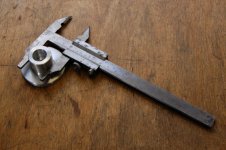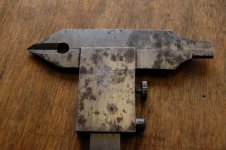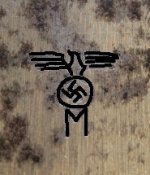I think a lot of Europe used a combination of measurement systems. This was primarily in the area of threading. In countries which otherwise used the Metric system, pipe threads might be the British tapered pipe or British Straight Pipe. On steam locomotive boiler work, a lot of the world seemed to favor the British Whitworth Threads for staybolts. I've done the boiler calculations on some Swedish built steam locomotives that were brought into the US & Canada. This is where I saw the mix of metric dimensions on all the parts of the boiler, and the odd use of inch dimensions for some of the pipe threads and staybolt threads.
The other thought which crosses my mind as I read this thread is the idea that the caliper has dual graduations to handle work on stuff imported into Germany. Look at the thread with the photo of the old machine tool dealer, and there were a lot of US made machine tools imported into Germany prior to the start of WWII. Think of something like an automotive repair garage prior to WWII, and there would have been automobiles and trucks imported from the USA. Think of a machinist working in a shipyard, and a merchant vessel might have been built in England or the USA.
Conversely, as a modern day example: at our powerplant, we have four (4) Hitachi pump turbine units. These were built ca 1970-72, at Hitachi's main works in Japan. I believe the drawings were specified by contract to have dimensions in inches and to use Unified Standard Form threads. However, leave it to Hitachi to slip a few wild cards in. On the high pressure hydraulic lines, they used British Straight Pipe Threads with copper gaskets. Here and there, we find metric threads. In our high voltage switchyard, we had air circuit breakers made by Brown Boveri (since replaced with modern SF 6 breakers). The old Brown Boveri equipment used all metric dimensions and metric threads on the fasteners, but used British pipe threads. Go figure why.
Look at something so common as an automotive spark plug. Since the dawn of automobiles and motorcycles, the threads have been metric. Very early spark plugs in the USA used tapered pipe threads or US threads, but those were obsolete and all spark plugs seem to use a metric base thread.
I think the world uses whatever seems right to the engineers designing the job. Sometimes, in certain countries, major industrialization or heavy construction projects were done by firms from England or the USA. The whole country would be metric, but there would be a job done in feet and inches. When I worked in South America, there was this mix of systems of measurements and threads as a result. The metric system was the law of the land, but so much stuff was already in place made with dimensions in feet and inches that both systems seemed to be used interchangeably.
As for the caliper, I think the engraving on it may have been done by some guy "accepting it" or "making it property of" the German military or some part of the German government at the time. It looks like the kind of engraving a person in a toolroom might do, freehand with either a spark-engraver or perhaps a die grinder and very small grinding point. I kind of doubt it was done with any sort of machine like a pantograph or with a stamping die. But, I have a hard time imagining anyone in a real toolroom would do that kind of engraving job on a caliper. Probably just some guy who worked in a military supply depot who got told to mark all the tools as property of the German military. On something like a vernier caliper, he could not hit it with a steel stamp, so he had to freehand engrave the insignia. Maybe he stamped the insignia on with a rubber stamp and ink and then attempted to trace it in with a die grinder or electric spark etcher (as is used in tool rooms). The result is the crude looking job in the photos.
Zonko: Yesterday, I enjoyed the metric system in the Good Old USA. My wife and I were riding on our old BMW R 100/7 with another couple, riding their BMW R 90/6. We rode to this area of the Catskill Mountains, about 40 miles from our house, and had lunch in a German bakery. Lunch was a couple of bratwurst with German potato salad, sauerkraut, good bread, and a bottle of Wartsteiner. The ladies went for the desserts. My buddy's wife is from a small village outside Mainz, and the waitress was from Essen. Lunch was also a mixture of speaking German and English. After lunch, we rode through the back roads, and stopped at the local Brauhaus. It was built in 1948 by carpenters from Germany. Of course, we had no problems with liters of Wartsteiner beer.
My buddy and I work on the old "Airhead" BMW motorcycles. My mind still thinks in inches, so I have to transpose to metric. I've been riding the "Airhead" BMW motorcycles for 37 years, and still cannot get to thinking in metric. But, I never have a problem with beer measured in liters. Call me one of the oldtimers.









